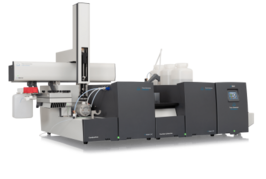- Home
- Eltra Elemental Analyzer
- TE Trace Sulfur/Nitrogen/Chloride Analyzer
- CHNSO Analyzer
- Coal Test Equipment
- Oil/Lubricant/Petroleum Analyzer
- Contact Angle Meter/tensiometer
- Electric Fluxer
- Food Analysis
- Furnace
- Spectrophotometer
- Viscometer
- UltraPure Water Purification System
- Laboratory Equipment Store
- Profile
- Contact

Combustion-Ion Chromatograph Model XPREP C-IC

Combustion Ion Chromatography
What is Combustion Ion Chromatography?
Combustion Ion Chromatography combines a combustion system with the analytical separation precision of an Ion Chromatograph in a fully automated configuration. Combustion Ion Chromatography (C-IC) enables the analysis of corrosive Halogens (Fluor, Chlorine, Bromine, and Iodine) and Sulfur compounds (e.g. Sulfate, Sulfite, Thiosulfate) in a wide range of sample matrices like polymers, organic solvents, and fuels. Corrosive halogens and sulfur compounds need to be monitored because they are corrosive, poison catalysts, damage industrial equipment and are harmful to the environment.
The analysis of speciated halides and sulfur in complex matrices like petrochemicals and solids is difficult and requires extensive sample preparation with conventional offline methods. Other detection techniques such as Oxidative Microcoulometry and UV-Fluorescence analyze Total Halogens (Total Chloride) and Total Sulfur as sum parameters. Combustion IC enables the determination of individual halides and sulfur by a single analysis while eliminating the complex and time-consuming sample preparation steps of conventional offline digestion/combustion methods, such as Schöniger Flask, Oxygen Bomb, Wickbold-Apparatus, and Microwave-induced combustion. Combustion Ion Chromatography not only reduces the cost of analysis but also significantly improves user-convenience and level of automation.
The principle of analysis consists of four steps:
1. A liquid, viscous, solid, gas or LPG sample of known weight or volume is introduced into the combustion unit at a controlled rate. Sample introduction is done either by boat inlet system or direct injection system, depending on the sample type and required detection level. Fully automated sample introduction can be achieved by means of an autosampler that suits the specific sample matrix.
2. Every sample matrix is completely oxidized by pyrohydrolytic combustion in an oxygen-rich environment at high temperature. Pyrohydrolytic combustion prevents loss of Fluorine in the quartz combustion tube. Halogens present in the sample are converted to H-X, X2, and Sulfur, to SOx.
3. After combustion, the output gas stream containing the analytes is transferred to a single- or multiple position absorber unit and trapped in the absorber medium. The absorber unit handles the rinsing and dosing of required reagents, including hydrogen peroxide (H2O2). In this process, the H-X, X2, and SOx are converted to F–, Cl–, Br–, I– and SO42-. The halide and sulfate anions will be separated on the IC column. The absorption tube(s) typically have a capacity of 10 or 20 mL.
4. After sample preparation, an aliquot of the absorber solution containing the analytes is injected into an Ion Chromatograph (IC) by means of a sample injection valve. The halide and sulfate anions are separated on the separator column of the IC. The conductivity of the eluent is reduced with an anion suppression device prior to the ion chromatograph’s thermal conductivity detector, where the anions of interest are analyzed. The IC detects the amount of speciated halogens (Fluor, Chlorine, Bromine and Iodine) and Sulfur compounds by calibrating the system. The combined system of pyrohydrolytic combustion followed by IC detection is referred to as Combustion Ion Chromatography (CIC).
Application Fields:
• Petrochemicals
• Fuels
• LPG & Gas
• Lubricants
• Organic Solvents & Chemicals
• Plastics & Polymers
• Environmental Monitoring
• Electronic Components (e.g. RoHS, WEEE compliance)
• Foods
• Minerals
• Coloring agents
• Polishing agents
Relevant International Test Methods: ASTM D7994, ASTM D7359, ASTM D5987, UOP 991, UOP 1001